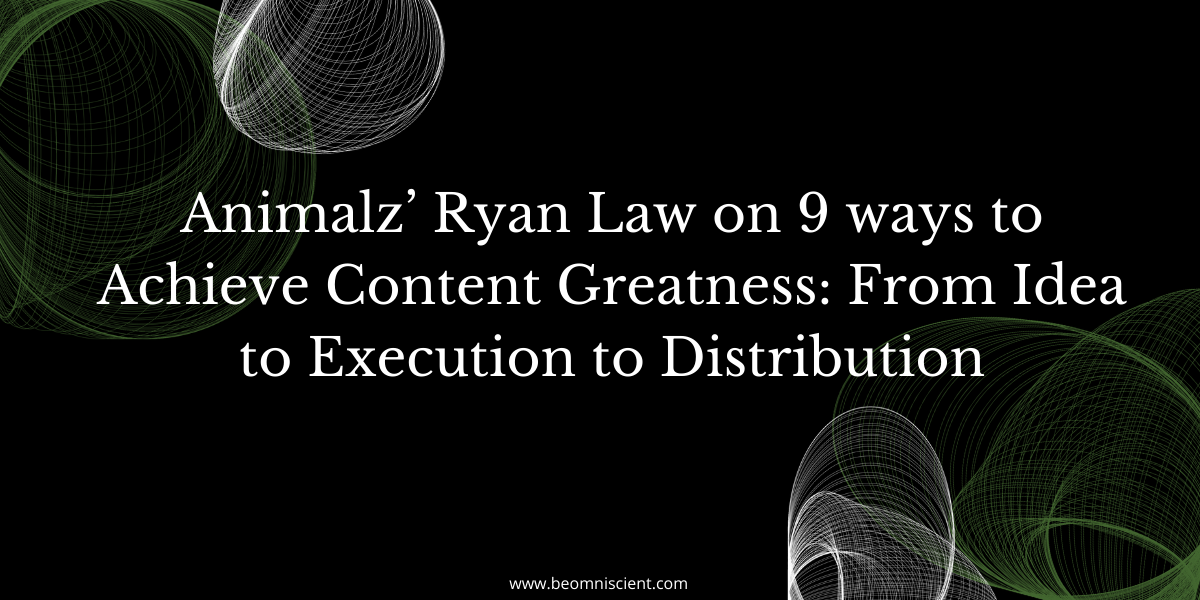
Content marketers need to constantly generate great ideas, produce stand-out content, and get results.
But sometimes the creative well runs dry. Or you have great ideas, but they’re not getting traction.
If anyone has the solutions to these problems, it’s Ryan Law, Director of Marketing at Animalz.
Here, Ryan shared nine surefire ways that marketers can spark creativity, generate memorable content, and get it in front of the right people.
1. Use your podcast as a way to learn
Maybe you started your podcast as a marketing channel to bring more attention to your company. But it should also be viewed as a way to learn from experts and generate ideas for new content.
Ryan said the Animalz podcast started out as team conversations on content. It was a way of distilling long blog post topics into a quick audio format.
But it was hard to translate that into measurable metrics, so their approach shifted.
Instead of focusing on the podcast as a way to attract customers, they’re looking at it as a way to boost content knowledge across the board.
“Increasingly I’m just trying to connect to people that I think we can learn from,” Ryan said.
He invites people who are leading conversations on niche parts of content marketing, like Blake Emal from the AI realm and Fio Dosetto for product-led content.
Not only is it a way to have fascinating conversations, which are great pieces of content in and of themselves, but everything they learn as a team can be channeled into new, original content.
“[We’re] using that as a way to learn from peers, and find discrete concepts that we can pull into our marketing,” Ryan said.
2. Let your ideas evolve
It’s an unspoken rule of content: the first time you cover a topic won’t be the best way you cover it.
With the rate at which content marketers put out content, that first iteration is just that. A first attempt at articulating an idea.
“I really enjoy looking back through the last 50 posts we published on the Animalz blog, because you can actually see this evolution of ideas happening throughout that,” Ryan said.
What happens is you get an idea, write it, and publish it. Then as you write about other topics, and use some of the concepts you’ve written about before, things start to evolve and mesh together.
When you publish an article that’s well-written, successful, and resonates, it’s probably not the first time you’ve touched on that topic.
“We’ve already written about them 10 times in some kind of earlier, more nascent format,” Ryan said of some of their most popular topic themes.
“It’s taken that long to kind of consolidate, sit with, learn from, process, and create that more polished final state version of that idea.”
3. Make connections beyond content
If you’re wondering where these content ideas come from, you’re not alone. Sometimes coming up with new ideas feels like the hardest part of content marketing.
Jimmy Daly, former VP of Growth of Animalz and now the founder of Superpath, got his ideas from sitting in on the sales process. He’d take the concerns voiced by prospective clients and generate content that addressed them.
Ryan likes to take this idea a step further, looking completely outside of a company or industry for inspiration.
“I’m a really big fan of taking models from other disciplines and thinking, how does that apply to content?” Ryan said. “Is there something we can learn from that? Some underlying universal principle?”
He uses a network note-taking tool called Obsidian.md to document any interesting concept he discovers.
“Every time I come across a cool model or a framework or a principle, I dump it in there and I try and build as many connections between it as I can,” he said.
The goal is to think: how does this apply to content in particular?
4. Coin a new concept
Once you have a good idea, there’s no guarantee it won’t flop upon publication.
Ryan said his favorite technique for making content memorable (and therefore shareable) is to coin a concept.
Challenge yourself to come up with a catchy phrase for whatever you’re discussing.
A couple of examples are “product-led content” and “copycat content.” Those are terms people in content marketing came up with to describe certain types of content. Now, we use them all the time.
“It needs to be some metaphor, some analogy that is just a really great framing for explaining the topic in the first place,” Ryan said. “That almost has to be the first thing you come up with.”
You should start with the theory or coined concept and then work that throughout the article instead of just slapping it into the title.
Here at Omniscient we came up with the Barbell Strategy, which is a coined concept we came up with after reading about Nassim Taleb’s barbell theory of portfolio allocation.
We modified it to describe our approach to content, which is putting 80% of your effort in proven, SEO content, and then 20% into more experimental, buzzworthy content.
Ryan suggests choosing an already popular topic in another discipline that you can make connections to. Then, appropriate it to transform it into a content marketing equivalent.
5. Understand a community’s quirks
When writing content for a community outside of your own niche, it’s important to do more than just research the facts.
Ryan talked about the importance of understanding the community’s shibboleths — the little quirks, shared values, and ways of communicating that are unique to them.
“Even if you can kind of intellectually grasp the subject you’re writing about, working out what their shibboleths are is so hard,” Ryan said.
“You can’t really do it without being a part of that community. Quite often that’s how a lot of that content fails that sniff test it. It doesn’t have those little hallmarks of validity that you should have.”
The way you can overcome that is by talking to people who are subject matter experts.
“So much of our research for so many of these companies and customers is just interviewing people and finding people that have been doing this thing for 20 years,” Ryan said.
Run your ideas past those experts, have them review drafts, and find out what they’re interested in. Then, you’ll be better able to distill that knowledge into functional content.
“In some cases, it’s less about learning the subject and more about becoming this conduit for other people’s experience to come through in the article,” said Ryan.
6. Reach the right people
Instead of blasting your content to every channel and every person you can reach, targeted thought leadership distribution can be a much more efficient way to reach customers.
“If you talk to people from the select community you want to reach, like VPs or directors of marketing or whatever that is, you’re going to get a much better understanding of where they go for their information,” Ryan said.
For example, Animalz does very targeted distribution to popular industry newsletters and professional communities to reach their target audience.
Dark social is also an important channel for distribution. WhatsApp, Telegram, Slack communities, and Discords can all offer niche groups primed for your content.
“If an article reaches those groups, maybe it will rack up a hundred views if you’re lucky. But potentially that could be 10 really interested prospects, because that community is just absolutely tailor-made,” Ryan said.
7. Consider the maturity of your industry
How you approach any given piece of content should also be determined by the maturity of your industry.
If it’s a saturated content market, you need to be different to stand out. You’ll need to experiment more and explore more contrarian views.
“There are some industries where, HubSpot is a classic example, it basically popularized content marketing, and the entire marketing automation space is so laden with content now that anything you do has to stand out,” Ryan said.
In those markets, differentiation is key to get results.
But there are other industries where content marketing hasn’t really been the main driver. Maybe buying is mainly offline, or there are compliance issues to work around when making content.
“Because content marketing hasn’t been used in those industries, you can do very basic, very foundational things and still get disproportionate results from it,” said Ryan.
Sometimes that means keeping it simple. Don’t waste time and energy over-engineering a solution if you don’t have to.
8. Create guardrails for writing
Content marketing requires a lot of writing and a lot of creativity, but it also requires structure and schedules.
How do you keep to a working formula while nurturing creative ideas?
“Content marketing is trying to be creative on a schedule,” Ryan said. “And the only thing I’ve found helps people do that predictably and consistently is process. Is outlining content and trying to guardrail what you’re writing as much as possible.”
The key is to leave creative wiggle room within that plan.
Yes, you want a starting point, ending point, and key things you want to hit in your content. But stop the planning there.
“If you do those three things, it’s functional,” Ryan said. “It achieves the basic goal you want to do. But in terms of how you get between those points, the sky’s the limit kind of thing.”
Let yourself have the freedom to creatively get between those points, otherwise you’ll find the process excruciatingly dull, and the end result will lack a creative spark.
9. Remember that good ideas are better than good writing
This is a hard concept to swallow for content marketers, but it’s a necessary one to be successful.
“One of the self-limiting beliefs I see a lot of content marketers have is that they love being writers and they care about being writers,” Ryan said.
“They are so reluctant to lose that identity that they don’t embrace the full breadth of skills and abilities and experiences that are necessary to be a great marketer.”
Writing is an important facet of content marketing, but it’s not the only important part.
“Great ideas can survive bad writing, but bad ideas will not be lifted up by great writing,” Ryan said.
Even terrible writers can get good results from a great idea.


